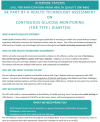Continuous Monitoring of Glucose for Type 1 Diabetes: A Health Technology Assessment
- PMID: 29541282
- PMCID: PMC5836597
Continuous Monitoring of Glucose for Type 1 Diabetes: A Health Technology Assessment
Abstract
Background: Type 1 diabetes is a condition in which the pancreas produces little or no insulin. People with type 1 diabetes must manage their blood glucose levels by monitoring the amount of glucose in their blood and administering appropriate amounts of insulin via injection or an insulin pump. Continuous glucose monitoring may be beneficial compared to self-monitoring of blood glucose using a blood glucose meter. It provides insight into a person's blood glucose levels on a continuous basis, and can identify whether blood glucose levels are trending up or down.
Methods: We conducted a health technology assessment, which included an evaluation of clinical benefit, value for money, and patient preferences related to continuous glucose monitoring. We compared continuous glucose monitoring with self-monitoring of blood glucose using a finger-prick and a blood glucose meter. We performed a systematic literature search for studies published since January 1, 2010. We created a Markov model projecting the lifetime horizon of adults with type 1 diabetes, and performed a budget impact analysis from the perspective of the health care payer. We also conducted interviews and focus group discussions with people who self-manage their type 1 diabetes or support the management of a child with type 1 diabetes.
Results: Twenty studies were included in the clinical evidence review. Compared with self-monitoring of blood glucose, continuous glucose monitoring improved the percentage of time patients spent in the target glycemic range by 9.6% (95% confidence interval 8.0-11.2) to 10.0% (95% confidence interval 6.75-13.25) and decreased the number of severe hypoglycemic events.Continuous glucose monitoring was associated with higher costs and small increases in health benefits (quality-adjusted life-years). Incremental cost-effectiveness ratios (ICERs) ranged from $592,206 to $1,108,812 per quality-adjusted life-year gained in analyses comparing four continuous glucose monitoring interventions to usual care. However, the uncertainty around the ICERs was large. The net budget impact of publicly funding continuous glucose monitoring assuming a 20% annual increase in adoption of continuous glucose monitoring would range from $8.5 million in year 1 to $16.2 million in year 5.Patient engagement surrounding the topic of continuous glucose monitoring was robust. Patients perceived that these devices provided important social, emotional, and medical and safety benefits in managing type 1 diabetes, especially in children.
Conclusions: Continuous glucose monitoring was more effective than self-monitoring of blood glucose in managing type 1 diabetes for some outcomes, such as time spent in the target glucose range and time spent outside the target glucose range (moderate certainty in this evidence). We were less certain that continuous glucose monitoring would reduce the number of severe hypoglycemic events. Compared with self-monitoring of blood glucose, the costs of continuous glucose monitoring were higher, with only small increases in health benefits. Publicly funding continuous glucose monitoring for the type 1 diabetes population in Ontario would result in additional costs to the health system over the next 5 years. Adult patients and parents of children with type 1 diabetes reported very positive experiences with continuous glucose monitoring. The high ongoing cost of continuous glucose monitoring devices was seen as the greatest barrier to their widespread use.
Figures












Similar articles
-
Flash Glucose Monitoring System for People with Type 1 or Type 2 Diabetes: A Health Technology Assessment.Ont Health Technol Assess Ser. 2019 Dec 12;19(8):1-108. eCollection 2019. Ont Health Technol Assess Ser. 2019. PMID: 31942227 Free PMC article.
-
Multi-gene Pharmacogenomic Testing That Includes Decision-Support Tools to Guide Medication Selection for Major Depression: A Health Technology Assessment.Ont Health Technol Assess Ser. 2021 Aug 12;21(13):1-214. eCollection 2021. Ont Health Technol Assess Ser. 2021. PMID: 34484487 Free PMC article.
-
Cost-effectiveness of sensor-augmented pump therapy in two different patient populations with type 1 diabetes in Italy.Nutr Metab Cardiovasc Dis. 2018 Jul;28(7):707-715. doi: 10.1016/j.numecd.2018.03.011. Epub 2018 Apr 5. Nutr Metab Cardiovasc Dis. 2018. PMID: 29753586
-
Health-economic analysis of real-time continuous glucose monitoring in people with Type 1 diabetes.Diabet Med. 2015 May;32(5):618-26. doi: 10.1111/dme.12661. Epub 2015 Jan 6. Diabet Med. 2015. PMID: 25483869
-
Cost-Effectiveness of Sensor-Augmented Pump Therapy with Low Glucose Suspend Versus Standard Insulin Pump Therapy in Two Different Patient Populations with Type 1 Diabetes in France.Diabetes Technol Ther. 2016 Feb;18(2):75-84. doi: 10.1089/dia.2015.0224. Epub 2015 Dec 8. Diabetes Technol Ther. 2016. PMID: 26646072
Cited by
-
Flash Glucose Monitoring System for People with Type 1 or Type 2 Diabetes: A Health Technology Assessment.Ont Health Technol Assess Ser. 2019 Dec 12;19(8):1-108. eCollection 2019. Ont Health Technol Assess Ser. 2019. PMID: 31942227 Free PMC article.
-
Experiences of Young People and Their Caregivers of Using Technology to Manage Type 1 Diabetes Mellitus: Systematic Literature Review and Narrative Synthesis.JMIR Diabetes. 2021 Feb 2;6(1):e20973. doi: 10.2196/20973. JMIR Diabetes. 2021. PMID: 33528374 Free PMC article. Review.
-
Adjustment of Insulin Pump Settings in Type 1 Diabetes Management: Advisor Pro Device Compared to Physicians' Recommendations.J Diabetes Sci Technol. 2022 Mar;16(2):364-372. doi: 10.1177/1932296820965561. Epub 2020 Oct 26. J Diabetes Sci Technol. 2022. PMID: 33100030 Free PMC article.
-
Intermittent Use of Continuous Glucose Monitoring: Expanding the Clinical Value of CGM.J Diabetes Sci Technol. 2021 May;15(3):684-694. doi: 10.1177/1932296820905577. Epub 2020 Feb 17. J Diabetes Sci Technol. 2021. PMID: 32064909 Free PMC article.
-
Improving patient self-care using diabetes technologies.Ther Adv Endocrinol Metab. 2019 Jan 28;10:2042018818824215. doi: 10.1177/2042018818824215. eCollection 2019. Ther Adv Endocrinol Metab. 2019. PMID: 30728941 Free PMC article. Review.
References
-
- Canadian Diabetes Association. Diabetes Statistics in Canada [Internet]. Toronto (ON): The Association; 2016. [cited 2016 Dec 7]. Available from: http://www.diabetes.ca/how-you-can-help/advocate/why-federal-leadership-...
-
- JDRF. Type 1 diabetes: about T1D [Internet]. Toronto (ON): JDRF; 2016. [cited 2016 Dec 7]. Available from: http://www.jdrf.ca/news-and-media/fact-sheets/type-1-diabetes/
-
- Canadian Diabetes Association. Types of diabetes [Internet]. Toronto (ON): The Association; 2016. [cited 2016 Nov 10]. Available from: http://www.diabetes.ca/about-diabetes/types-of-diabetes#sthash.wQM6BPDc....
MeSH terms
Substances
LinkOut - more resources
Full Text Sources
Medical
